When you are planning your optimal growing facility, there are many factors to consider. One crucial piece of the puzzle is grow lighting – and it should be something that is factored in at the beginning of the project.
While considering your optimal growing facility, many project managers or planners will use computer simulations to plan out and design the room prior to investing in grow lighting. And this is crucial to getting optimal lighting for the crop you plan to cultivate.
When you bring a lighting manufacturer into the process, they will likely have computer models they’ll show you so you can see how your grow lights will be placed in your new facility and how you can arrange plants to make the most of your space.

And there are tools out there those reputable manufacturers have that can simulate a grow facility during the planning process, to help iron out any issues before you invest money – and start to grow.
So, how does this all work? When you are considering how to place grow lights in your optimal growing facility, you give the layout or plans to your lighting manufacturer. Then, they will take that drawing and translate it to work in an online simulator, generating a room that shows how many photons will hit the canopy.
The No. 1 goal when building your optimal growing facility should be trying to optimize getting as much light on as much of the plant as possible.
Growers need to make sure every single watt that is being consumed in that room is efficiently used. The goal should be: No wasted watts.
And that can best be done on the computer, using modeling and simulation.
So, how do you make sure the numbers you are looking at are accurate?
There are a few questions you can – and should ask – your lighting manufacturer. The truth is, there are some not-so-honest manufacturers who will use deceptive techniques to embellish the results of computer simulations to make a sale. For growers, it might look great on paper, but if you don’t ask the right questions, you might not be getting the full picture.
Here’s what to ask, when considering lighting for your optimal growing facility:
- What light loss factor (LLF) are you using?
When you are given an estimate for how much light will be hitting your plants, there is a formula that’s used to determine that number. For LED lights, 0.9-0.95 of the light hitting the plant is realistic to expect when the lights are new (all lights lose potency the longer they are on) and before dust, dirt and other debris float around and obscure the amount of light hitting the plant.
The very first time you turn a light on it is 100 percent strength – full potency. But it degrades over time. In the horticultural world, when a bulb goes down below 90 percent efficiency, that means it is nonfunctional and needs replacement because there is a direct correlation between the degradation of the light source and the yield.
When light manufacturers run their computer simulations to determine your grow light needs, they have to enter a number in the simulation to determine placement, type of light and other factors. The difference is, reputable manufacturers won’t put that value at 100 percent – because you will only get 100 percent early on in the process. Non-reputable light manufacturers can fudge results by using 100 percent in their calculations instead of 95 percent which is more realistic because it accounts for degradation.
This can cause issues down the line with performance and growth patterns in your optimal growing facility, so it’s important to understand how your light manufacturer is calculating LLF before you invest in their product.
- What min/max factor came out of the computer simulation of my grow facility?
This second question is also important to ask – and understand – before you purchase grow lights. In horticulture, the min/max tells growers the ratio of high amounts of light to low amounts of light spread across the facility.
This is important because if you hover lights over a space, the plants directly under the light bar will get more light and thus, perform better than plants not directly under a light.
An ideal min-max number for a standard growing facility is 2 or less, because you really want the light to hit every plant as uniformly as possible. Some facilities with older light technology can have larger swings in the min/max – leading to less uniformity in plant .
And finally, there is a reflectivity factor that can skew the final results. For example, if the person doing the calculations indicates all the surfaces are white rather than the gray color that might be used on the floor and ceiling, the PPFD metric is likely to be overstated.

Here is an example of a lack of uniform growth in cannabis plants.
The use of LED lights properly planned and placed in your optimal growing facility can reduce these min/max swings because they are more uniform to begin with and there is not just one bulb over the center of the plant. In a properly designed and lit facility, there will be thousands of LEDs hovering over the whole facility which will eliminate hot spots. As a grower, your goal should be to achieve a consistent canopy, with each plant in the facility grown to a similar height.
The Key Takeaway
As with any large purchase – and any business – the key to getting the best product for the best price is to educate yourself and always ask questions. And in this instance, you need to know the questions to ask – and the answers to expect.
Choosing lighting for your optimal growing facility is an expensive and time-consuming task, but getting it right means you’ll waste less energy, grow more product and in the end, will pay dividends for years into the future.


